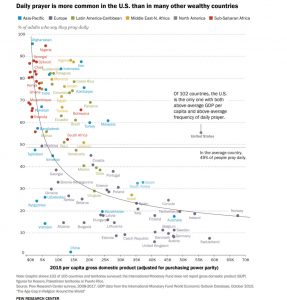 The Age Gap in Religion Around the World (Pew Research Center, June 2018) is packed with enough data to keep anyone interested in religious trends busy reading and pondering for quite some time. This new data supports the common claim that younger generations are less religious than elder both globally and in the United States.
The Age Gap in Religion Around the World (Pew Research Center, June 2018) is packed with enough data to keep anyone interested in religious trends busy reading and pondering for quite some time. This new data supports the common claim that younger generations are less religious than elder both globally and in the United States.
Of the 96 pages one captured my attention in a way the others did not. Page 21 (screenshot at right) offers a full page graphic showing the association between a country’s wealth (measured by per capita gross domestic product) and its average rate of daily prayer.
The United States is the obvious outlier. More specifically:
Countries with higher levels of wealth typically have lower levels of prayer, and vice versa. In every surveyed country with a GDP of more than $30,000 per person, fewer than 40% of adults say they pray every day – except in the United States (p.20).
America the Prayerful
55% of Americans say that they pray on a daily basis.
Fifty-five percent.
And, older Americans are more likely to pray with this frequency than are younger Americans:
- < 40: 44%
- 40+: 62%
So What?
The prayer gap between Americans 40 and over and those under 40 is 18%.
This gap is almost identical to the gap between the two groups on the question on the importance of religion (18% vs 17%). 43% of Americans under age 40 indicated that religion is very important to them while 60% of adults ages 40 and over expressed that view. The importance gap is 17%.
- Do any of the statistics included above (or in the full Pew report) surprise you? Explain.
- Based on what you know, why is America the outlier among more than 100 nations – covering the economic spectrum – when it comes to the frequency of prayer and wealth? What are some reasons that may explain why we are the only wealthy country with more than 40% of adults who say they pray on a daily basis?
- How does an awareness of these statistics help you better process the present American moment?